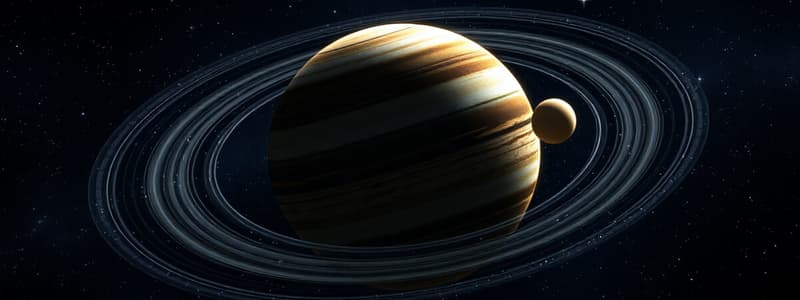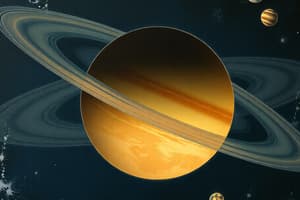Podcast
Questions and Answers
What modifications did Kepler make to Copernicus's model? (Select all that apply)
What modifications did Kepler make to Copernicus's model? (Select all that apply)
- Planets closer to the Sun move faster.
- Earth's rotation causes the rising and setting of the Sun. (correct)
- Planets spin in an epicycle while orbiting Earth.
- Venus has phases due to its orbiting of the Sun. (correct)
- Planetary orbits are elliptical. (correct)
How was Aristarchus's explanation of the movement of objects in the sky different from other scientists' earlier explanations? (Select all that apply)
How was Aristarchus's explanation of the movement of objects in the sky different from other scientists' earlier explanations? (Select all that apply)
- He discovered Venus's phases. (correct)
- He stated that the Sun is the center of the solar system.
- He described the epicycles of the planets in the sky.
- He explained the concept of retrograde motion. (correct)
- He argued that Earth rotates on its axis.
What observation did the geocentric model of the solar system help to explain?
What observation did the geocentric model of the solar system help to explain?
- Orbit speed
- Retrograde motion (correct)
- The rising of the Sun
- The phases of Venus
Which gaseous giants did Renaissance scientists such as Galileo know about? (Select all that apply)
Which gaseous giants did Renaissance scientists such as Galileo know about? (Select all that apply)
According to Kepler, which planet travels the fastest?
According to Kepler, which planet travels the fastest?
How did Kepler's discoveries contribute to astronomy?
How did Kepler's discoveries contribute to astronomy?
What do comets and asteroids have in common? (Select all that apply)
What do comets and asteroids have in common? (Select all that apply)
How did the Ptolemaic model differ from other proposed solar system models?
How did the Ptolemaic model differ from other proposed solar system models?
All planets have epicycles in solar system models.
All planets have epicycles in solar system models.
How did Kepler describe the planets' orbits?
How did Kepler describe the planets' orbits?
Flashcards are hidden until you start studying
Study Notes
Kepler's Modifications
- Modified Copernicus's model by introducing elliptical planetary orbits.
- Proposed that planets closer to the Sun move faster compared to those further away.
- Eliminated the concept of epicycles associated with Earth's motion.
Aristarchus's Unique Perspective
- Suggested that Earth rotates on its axis, differing from prior geocentric views.
- Contributed to understanding Venus's phases and motion through space.
- Posited that the Sun, not Earth, is the center of the solar system.
Geocentric Model Observations
- Geocentric model particularly explained retrograde motion observable in planets.
Renaissance Knowledge of Gaseous Giants
- Galileo recognized Jupiter and Saturn as the gaseous giants of the solar system.
- Mars, Neptune, and Uranus were not known in this context.
Fastest Planet According to Kepler
- Identified Mercury as the fastest planet in its orbit around the Sun.
Contribution to Astronomy
- Kepler's laws of planetary motion validated the heliocentric model, reshaping astronomical understanding.
Comets and Asteroids
- Both comets and asteroids orbit the Sun and are relatively small compared to planets.
Ptolemaic Model Characteristics
- The Ptolemaic model incorporated the idea of planets moving in epicycles around a stationary Earth.
Shared Traits of Solar System Models
- A universal trait among solar system models is the moon's orbit around Earth, while circular orbits are not universally accepted.
Kepler's Description of Orbits
- Described planetary orbits as elliptical, challenging the prior notion of circular orbits.
Studying That Suits You
Use AI to generate personalized quizzes and flashcards to suit your learning preferences.



